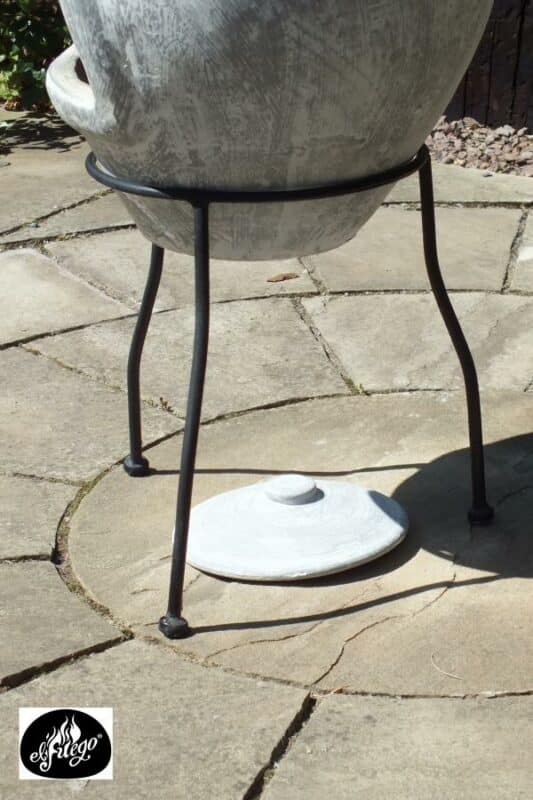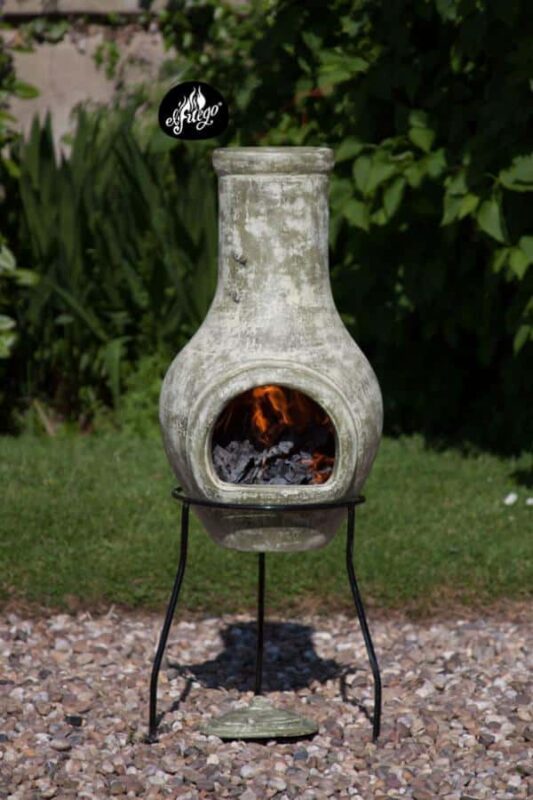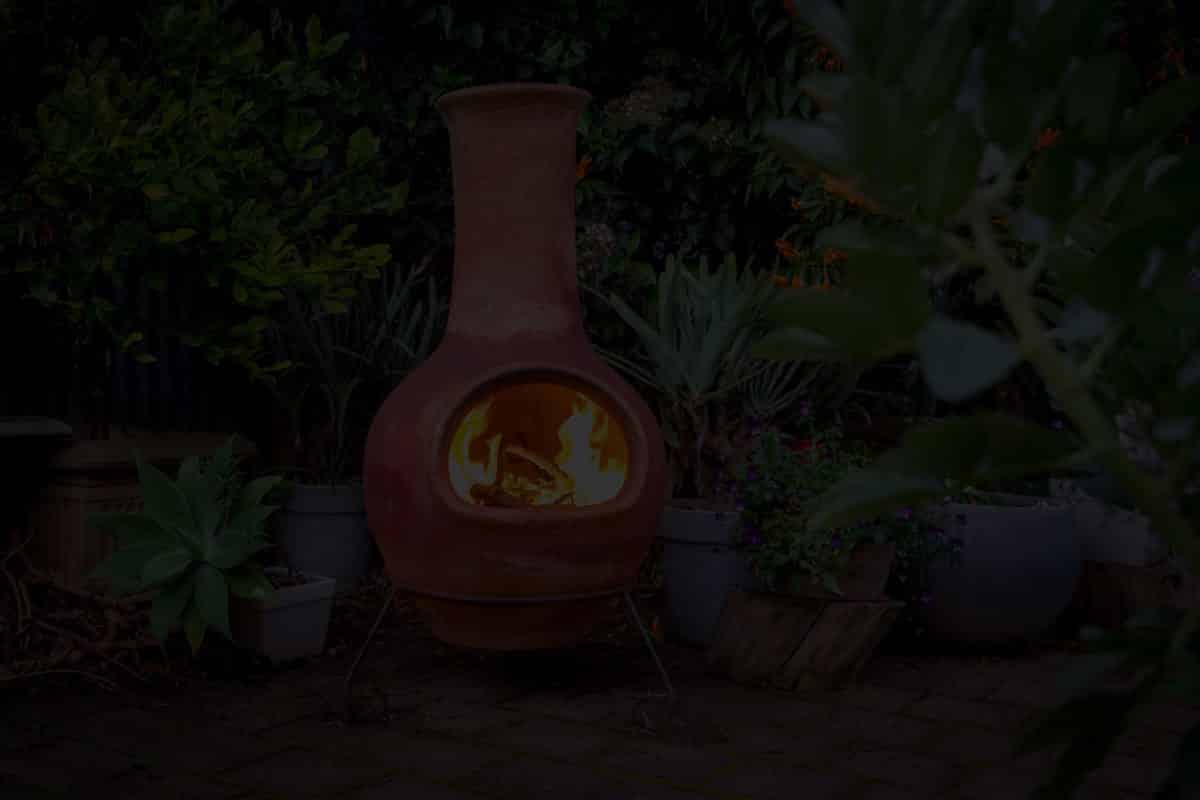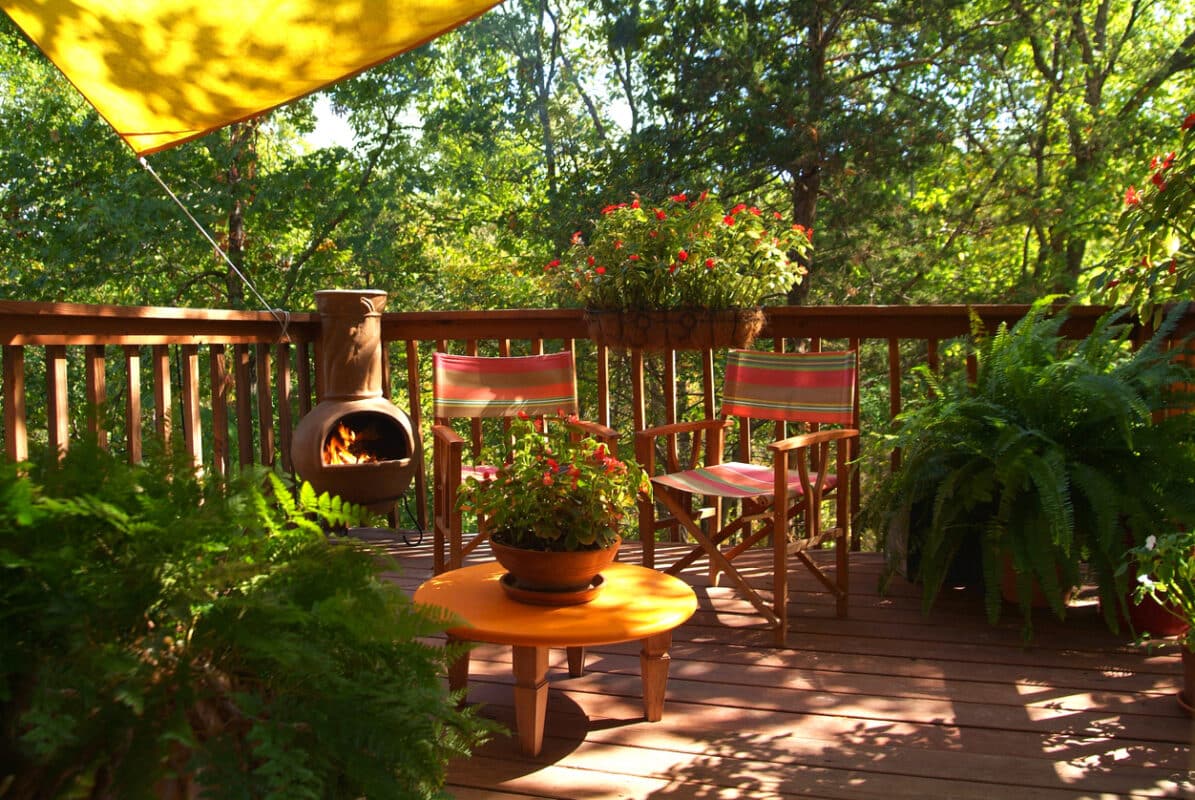Chiminea maintenance and care
Can I use a chiminea on a wooden deck?
Decking is marvellous stuff, giving you a flat, safe surface to sit, lounge, eat, drink, and socialise. So can you use a chiminea on a wooden deck? Yes, you can place a metal or clay chiminea on decking but, as you can imagine, there are some fire safety issues to bear in mind. Here’s how to do it safely, sanely and sensibly, without setting your decking, house or self on fire!

The risks of standing a chiminea on a wooden deck
Most decks are made from wood, but they also come in a composite material made from plastic and wood, or even just plastic. All these types of surface can be badly damaged by heat and fire. Even when you have your chiminea on a metal stand so the body doesn’t actually touch the decking itself, there are risks.
Let’s mention grass here. You can stand a chiminea on the lawn if you like. While the lawn won’t burn, it still makes sense to buy or make a suitable fireproof may or surface to sit it on, so the grass doesn’t get scorched. Gravel makes an excellent safe surface and it’s very simple to make – see the image at the bottom of the article.
A word about chiminea quality… while Mexican chiminea designs are brilliant at keeping any ash safely inside the belly, not all chims are equal. So, for a start, make sure you invest in a quality Mexican chiminea rather than a cheap and nasty design that doesn’t perform anywhere near as well and throws out ash and sparks.
You should always site a chim away from anything that might catch fire. So make sure there’s enough room all around it for everyone’s safety.
It’s really important to protect the composite or wooden decking from heat, so you’ll need to stand it on a protective layer. The simple heat proof mats (sometimes called a ‘deck defender’) that you can buy for fire pits do a perfect job and look good, too. They’re easy to use, easy to keep clean, and cost very little. Use one even when your chim is on a metal stand and you’ll protect your deck from any flying sparks and hot ash.
Alternatively you can build your own very simple, effective and attractive protective stand for the chiminea using decorative paving slabs or bricks. You can even paint it or mosaic it for something a bit different. Just make sure the surface is as flat as possible so your chim doesn’t wobble. Because so many metal chiminea stands are three-legged, they’re designed to stand firm even on a surface that isn’t perfectly flat. But it’s safest when they’re 100% upright rather than leaning like the tower of Pisa!

It’s even possible to use the fire safety blankets we sell as a surface to stand your chiminea. While it doesn’t look as good as a proper fire mat or paved stand, it’ll do the job. Maybe as a decent temporary solution until you buy or make a proper surface for your chim to stand on.
Whatever you use to protect your deck or lawn, it’s always wise to keep an eye on the fire while it’s burning, never a good idea to leave a fire of any kind to burn – or burn out – on its own. Take care when putting the fire out. And avoid moving your chim while it’s still hot. All this should help keep your decking safe from burning and melting.
If the chiminea you’ve bought doesn’t have attached legs or a separate stand, which means you’ll need to stand it on its belly, you need to be very careful indeed simply because the bottom gets so hot. You’ll need to take extra care over making or buying a fireproof stand for it so your wooden deck doesn’t burn, or your composite deck doesn’t melt
One cool tip. You’ll usually need to add a layer of special pumice stones called lava stones to the belly of your clay chiminea. It’s the best way to protect the bottom against excessive heat, something you’ll usually need to do with any clay chiminea to stop it cracking through heat stress. Because it’s such a reliable way to stop the bottom getting really hot, it helps protect your decking.
Safety tips for using a chiminea on garden decking
- Always check your chiminea before lighting it, looking for cracks and breaks that can present a fire hazard
- Stand the chim well away from anything that could catch fire or be damaged by heat – garden furniture, potted plants, overhanging shrubs and so on
- Ideally you’ll want to site it at least 10 feet from your house
- Never burn a large fire inside a chim. There’s no need. The idea is to set small, economical fires that heat up the body to a high temperature like a huge radiator. Make your fire too big and you can crack the body, which comes with a risk of fire spreading
- Because clay is porous, it absorbs water. If your chiminea has been out in the wet and has soaked up water, set a very small fire to help the clay dry out and prevent cracking as the water expands
- If you’re lighting her up in dry weather, make sure there’s nothing that can set fire in the immediate area
- Keep a bucket of dry sand – or soil – nearby so you can kill the flames fast if you need to. Don’t use water. The thermal shock you’ll get from hurling a bucket of cold water onto a hot clay chiminea will probably cause it to crack or break into pieces. In an ideal world it’s always best to simply let the fire cool down and burn out naturally
- Always have a fresh fire blanket available – when you’ve used it, replace it with a new one
- Metal chimineas often have a simple spark arrestor inside, at the top of the chimney. If not, make your own using a simple circular piece of chicken wire. It’ll help stop embers and sparks from becoming a fire hazard
- Never cover a lit chiminea. They need lots of ventilation to let the carbon monoxide released by any sort of fire to escape safely into the air. That means no overhanging plants, no garden umbrellas or gazebos, and no makeshift shelters or lean-tos
- Use the right fuel – usually wood for a clay model, or wood / charcoal for a metal version
- Never use fire accelerants like lighter fuel or petrol. They’re far too fierce. Stick to kindling and screwed-up paper for a gentler, slower, safer burn
- If you need to move a clay chiminea, grab a friend. The weak point between the belly and the chimney, the place where the two pieces are joined, mean you should take care. Never pick a chim up by its chimney. Support the belly properly before lifting it carefully from the bottom, and only move it once it has completely cooled down
Now you know how to safely stand a chiminea on a wooden deck or composite decking. We wish you many, many awesome outdoor events in the company of your chiminea – in safety!



